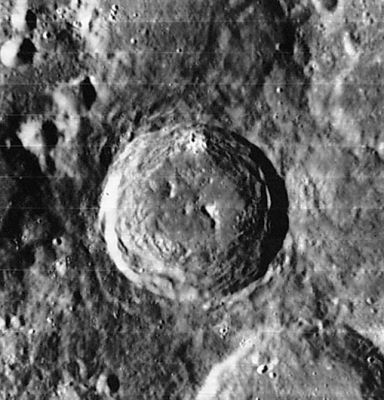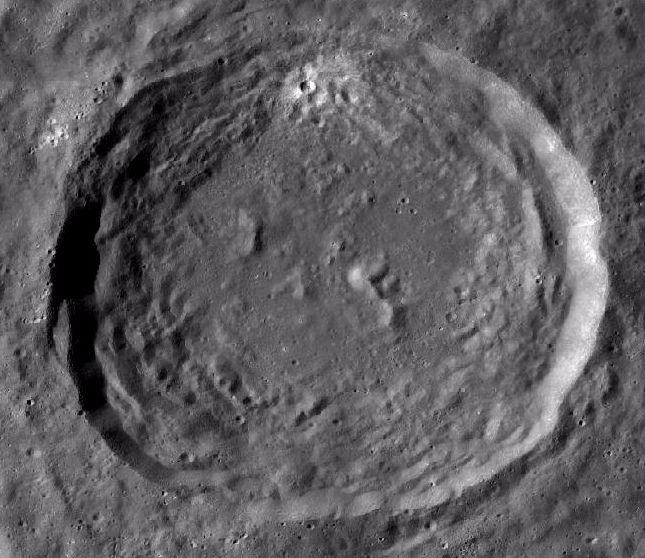Werner
Werner (with high-albedo craterlet Werner D on its northern inner slope)
|
Lat: 28.0°S, Long: 3.3°E, Diam: 70 km, Depth: 4.2 km, Rükl: 55, Eratosthenian |


LOIV 101 H1 (on the left) and LRO (on the right).
Images
LPOD Photo Gallery Lunar Orbiter Images Apollo Images
Maps
(LAC zone 95C4) LAC map Geologic map
Description
Description: Elger
(IAU Directions) WERNER.--A ring-plain, 45 miles in diameter, with a massive rampart crowned by peaks almost as lofty as any on that of Aliacensis, and with terraces fully as conspicuous. It has a magnificent central mountain, 4,500 feet high. At the foot of the N.W. wall Madler observed a small area (Werner D), which he describes as rivalling the central peak of Aristarchus in brilliancy. Webb, however, was unable to confirm this estimate, though he noted it as very bright, and saw a minute black pit and narrow ravine within it. Neison subsequently found that the black pit is a crater-cone. It would perhaps be rash, with our limited knowledge of minute lunar detail, to assert that Madler over-estimated the brightness of this area, which may have been due to a recent deposit round the orifice of the crater-cone.
Description: Wikipedia
Additional Information
- Depth data from Kurt Fisher database
Pike, 1976: 4.2 km
Westfall, 2000: 4.2 km
Viscardy, 1985: 4.22 km
Cherrington, 1969: 4.57 km - TSI = 35, CPI = 25, FI = 20; MI =70 Smith and Sanchez, 1973
Werner D's high-albedo ejectablanket
A fine test object for every kind of telescope is the small crater at the centre of the high-albedo ejectablanket on the northern part of Werner's rim (officially known as Werner D). Are there possible changes in the brightness of that ejectablanket? (several dedicated moonobservers of the past compared it with "similar" changes of brightness at other high-albedo spots such as Lassell D, Linné, and Posidonius Gamma).
- DannyCaes Aug 23, 2015
The hook-shaped tracks of the boulders in Werner D's ejectablanket
It's interesting to explore the LRO's NAC close-ups of the ejectablanket around Werner D. The location of the bright crater Werner D is on the northern inner slope of Werner itself. The tracks of almost each one of the ejected boulders (from Werner D) look remarkably "hook-shaped", because they rolled down the slope, southward.
- DannyCaes Aug 29, 2017
Nomenclature
- Johannes Werner (February 14, 1468 – May 1522) was a German mathematician. His primary work was in astronomy, mathematics, and geography, although he was also considered a skilled manufacturer of instruments. Many consider Werner as a pioneer of modern meteorology and weather forecasting. Between 1513 and 1520, Johann Werner made the first regular observations of the weather conditions in Germany.
- Werner Alpha (the central peak of Werner) (see Chart 83 in the Times Atlas of the Moon).
LPOD Articles
Werner, Werner, Werner, Werner Like Getting New Glasses
Bibliography
The Werner D bright spot:
A.J.M.Wanders, Op Ontdekking in het Maanland (Het Spectrum, 1949), pages 280-281.